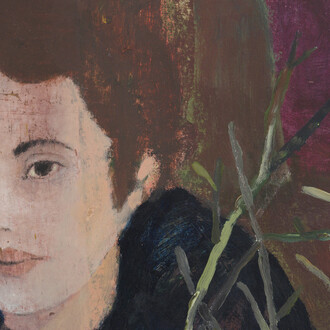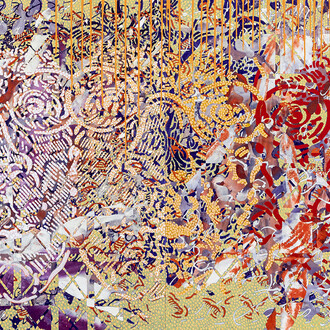VNH Gallery is delighted to announce the solo exhbition of the artist Giulia Andreani entitled « Intermezzo » (March 17 - April 28, 2018) inside our project space.
Giulia Andreani’s work has always been intimately linked to History, but it has never settled to act as a mere reiteration or visual substrate of the past. Surrounded by portraits of strangers that her father used to hang up on the wall, Giulia grew up developing her interest for written and visual testimonies that she studies and reinvents through her artistic practice. Her paintings and her works on paper are thus transformed into sensitive witnesses of a time or a moment via acrylic or watercolour painted portraits or scenes bathed in monochromatic bluish gradations, characteristic of the artist’s work.
Giulia navigates and articulates antic, modern and contemporary references by focusing on the details in order to reach universal considerations. In the exhibition “Intermezzo”, she delivers a series of works produced between two distinct realities she experienced through two different residencies, one in a Maternal Centre and another at the Villa Medicis. In both, maternity and the notion of archive were the most explicitly raised issues. As an example, two portraits, one of the French writer Virginie Despentes whose literary and cinematographic work sometimes refers to Malthusian feminism – which describes maternity as a “social function” to which women would be reduced to – and the other, the Pharaoh-queen Hatchepsout, condemned to oblivion through damnatio memoriae. These two portraits of women underline the two temporal terminations of this exhibition and they mischievously erect the exact same dimensions of Antonello da Messina’s virgin, ultimate symbol of completion through maternity, completion from which they are both so distant of.
By painting these juvenile faces of Rainer Werner Fassbinder, Pier Paolo Pasolini – paternal figures of 20th century cinema that maintained a deep relationship with their mothers, as they even appeared in some of their films – and Frida Khalo – painter and feminist figure – Giulia addresses the issue of childhood. She reconciles their faces to the ones of anonyms that she recently met during her residency in a Maternal Centre. Despite Giulia’s desire to engage more deeply with the story of these isolated young pregnant women or with a child of less than three years, she faced many administrative resistances that prevented her to do so. How can it be that the story of these women, which is being written today, become less approachable than other archives that Giulia usually digs into for her artistic work, archives that have crossed the centuries? In the end, she was pushed into narrowing down her artistic intervention to simple workshops such as making mandalas or paper masks.
Here, Giulia pays tribute to these young women that were welcomed into organizations whose objective is to “transform” them into “good mothers”, responsible adults, and often through neglecting their own personal development. Hence, the watercolour series “LLAMVSS” (2018) was made from photographs taken by the artist with the initial goal of working on the issue of self-portrait with the residents of the Maternal Center. Partially obliterated by the sentences taken from the very strict form Giulia had to sign upon arrival to the institution, these faces symbolize this unbridgeable gap. Produced inside the Maternal Center, the painting “Guérillères” (2017) depicts women in uniforms walking in a determined way. This vision, in discordance with the context, was elaborated under the eyes of the young mothers to whom these acrylic heroines, like doppelgängers, offer a reflexion on their future, a potential alternative.
















